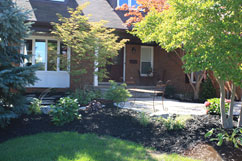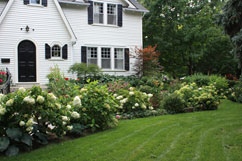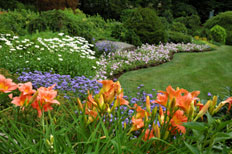Fall Pruning Guide: When to Trim Trees & How to Prune Shrubs
Getting the timing for when to complete fall pruning and tree trimming, and learning the proper ways of how to prune shrubs can make a big difference in the look of your garden, without any additional effort.
WHY PRUNE?
 If your favourite ornamental trees and shrubs don’t seem to be flowering like they used to, carefully timed pruning is often the best way to stimulate new growth and flowering. The late fall and early winter is one of the best times for pruning many plants.
If your favourite ornamental trees and shrubs don’t seem to be flowering like they used to, carefully timed pruning is often the best way to stimulate new growth and flowering. The late fall and early winter is one of the best times for pruning many plants.
It’s important to brush up on some basic pruning tips first, as doing it at the wrong time will actually result in fewer flowers. Here’s what you need to know before you get to cold weather clipping and cutting.
HOW TO PRUNE
The first step with any pruning project is to remove any deadwood, broken branches and damaged limbs or twigs. Cut back to the next intersection of live wood. If you are not sure, lightly scrape a very small section of the woody surface of the plant. There should be green under the outer layer of the stem or branch. Cut as close as you can to the branch that is going to remain without damaging it.
Cutting back to a juncture or intersection applies to most types of pruning. Unless you have a formal or topiary garden that demands straight lines and perfectly smooth shapes, it is better not to shear your shrubs. Most plants look better with their natural shape and form. They will be healthier, too. Cutting out some of the old limbs close to the ground in bushy shrubs will open them up and generate a lot of new growth.
SUMMER FLOWERING PLANTS
 In general, if a plant flowers in the summer or early fall, then late fall or early winter is a good time to prune it. Most plants form flowers on their new growth. Pruning in fall or winter gives summer bloomers the spring season to grow before they flower again. If you cut back spring flowering plants in the fall, then you have removed new growth and will see fewer flowers next year. Just remember to prune after flowers fade.
In general, if a plant flowers in the summer or early fall, then late fall or early winter is a good time to prune it. Most plants form flowers on their new growth. Pruning in fall or winter gives summer bloomers the spring season to grow before they flower again. If you cut back spring flowering plants in the fall, then you have removed new growth and will see fewer flowers next year. Just remember to prune after flowers fade.
FOLIAGE FAVORITES
Some plants are grown for their overall form and the characteristics of their leaves or wood, not for their flowers. For these plants, an early winter pruning is usually best. This will stimulate new growth when weather warms up at winter’s end.
If you have ornamental grasses in your landscape, fall and winter are often their showiest seasons. Many grasses flower in the fall and their foliage can take on shades of red, blue or brown. They make a striking contrast to a blanket of snow. Leave them alone until the very end of winter, then shear them to a few inches above the ground.
FLOWERING PERENNIALS

Note that most of these recommendations suggest late fall or early winter is the best pruning time. With mid-fall pruning you are likely to stimulate some late season growth. If there is a sudden frost, then the new, tender growth will be damaged.
Learning these simple rules of pruning can have a big impact on your flowering ornamental beds and landscape. Knowing the right time to prune and where to cut will rejuvenate your plants and keep them flowering year after year.
If you have any questions about fall maintenance or shrub pruning, contact us today.
- WHY TRUST IS SO IMPORTANT TO US - December 15, 2019
- MORE ON LANDSCAPE LIGHTING - February 16, 2019
- 5 Ways Landscaping Can Increase Your Home Value - January 5, 2019
